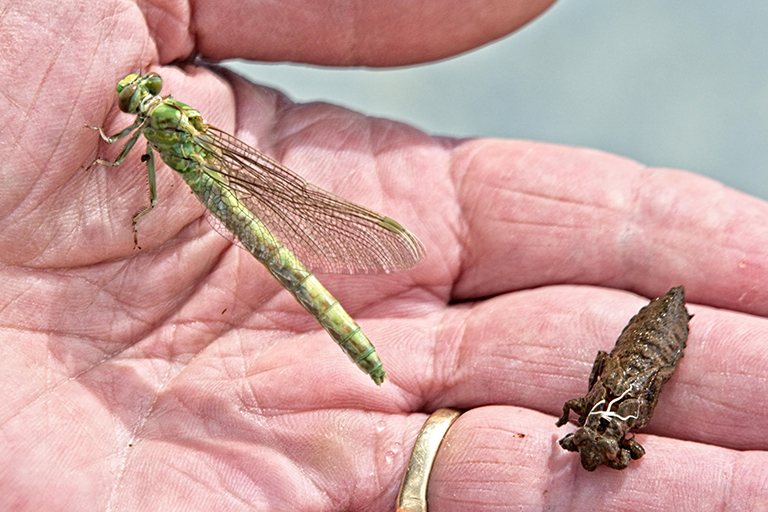By Dennis Smith
Three years ago, Pat Mulligan and I were fishing dry flies on a tiny creek near Walden and catching some pretty nice brook trout when a dragonfly nymph crawled up Pat’s waders, across his arm and into the palm of his hand. “Hey,” he hollered. “Come take a look at this thing.”
If you’ve ever seen one, you know dragonfly nymphs are flat-out, creepy-looking bugs: squat, thick-bodied creatures with armored legs, enormous bulging eyes and drab, spiky, dinosaur-like exoskeletons. They look like either something that just crawled out of “Jurassic Park” or a smaller version of the lead monster in one of those “Whatchamacallits-That-Ate-Tokyo” films.
But never mind. Now it was in Pat’s hand and in the process of morphing from a distinctly unattractive nymph into a Granny Smith apple-green, mosquito-eating predator with a long, slender body and four lacy wings that can rotate independently, permitting it to fly forward, backward, straight up and down, hover in place like a helicopter or accelerate like an F-18 on a strafing run.
“You ever seen one of these hatch before?” I asked Pat. Truth is, neither of us had, despite all the years we spent on the water chasing fish. Dragonflies hatch by the millions, all summer long, just about everywhere there’s a water source — lakes, ponds, creeks — and hardly anyone ever notices. Which got us to talking about some of the other wildlife drama we all see unfold while hunting or fishing; things that happen in nature, day in and day out, but which most of us fail to recognize or appreciate.
Like the silly seagulls back at our camp on North Delaney Buttes Lake. At first glance you might think they’re just cruising around aimlessly for the sheer joy of riding the wind, until one of them suddenly swoops into a stall, hovers momentarily, then folds its wings and dives like a missile into the surf to come up with a big brown crayfish from the mud-crusted bottom of the lake. How do they spot those things from so high in the air? It’s a marvel.
Two years ago, I was photographing a flock of pelicans herding schools of gizzard shad into a shallow bay on an irrigation reservoir. They drove the shad up against the bank, then encircled them and scooped them up in their amazingly elastic beaks and swallowed them whole like they were sipping down cherrystone clams. Some of those shad were as long as a grown man’s forearm. How do pelicans do that without choking to death?
Meanwhile, a great blue heron was stalking the shoreline like a ninja, spearing the panicked shad with its sword-like beak and piling them up on shore, presumably to eat later when the fishing slowed down. Or maybe he was just competing with the pelicans, thinking they were stealing “his” fish. I really don’t know, but it sure was fascinating to watch.
Dennis Smith is a freelance outdoors writer and photographer whose work appears nationally. He lives in Loveland.

